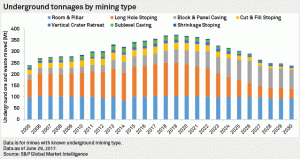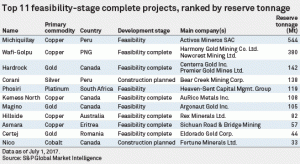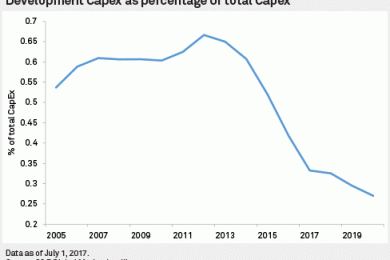Gregory Rodwell of S&P Global Market Intelligence asks if “underground metal mining will weather the under-investment storm? Despite fluctuations in the mining market over the past 12 years, the tonnage of ore and waste moved in underground mining operations has changed relatively little. This has provided certainty to underground suppliers generally, and to equipment manufacturers in particular. In recent years, however, severe cuts in development capital expenditure and a limited project pipeline has threatened the underground tonnage likely to be moved beyond 2020.
“Since 2005, the amount of material moved from underground base and precious metals mines has grown steadily, averaging a compound annual growth rate of 1.2% in the 11 years to 2016. This suggests that the decline in most commodity prices over the past five years has had very little effect on the reality of underground mining.
“S&P Global Market Intelligence expects an important increase in underground tonnage over the next two years. Detailed Mine Economics operating-cost models for 280 underground base and precious metal mines — fully underground or surface/underground operations — in the SNL Metals & Mining Database indicate that underground tonnage moved will experience a significant increase in 2017 and 2018.
“Although primary copper mines dominate underground tonnage, this is largely due to a small number of block and panel cave mines, such as El Teniente and Grasberg. The latter, where the block cave is expected to take over from the open pit in 2018, is largely responsible for this increase in tonnage over the next three years. However, primary gold underground mines were the standout gainers across the time period in percentage terms, from 64 Mt mined in 2005 to 119 Mt mined in 2016. The growth is strongly linked to the increase in the gold price from the late 2000s to 2012, with 146 primarily underground mines coming on stream in the decade since January 2007.
“While this dramatic fall has not had much impact on the day-to-day operations of mines so far, it can be expected to have a significant impact on mine supply in the coming years.
“Based on Market Intelligence’s models, underground tonnage volume is expected to grow over the next four years as new mines and expansions, funded during the period before 2013, come on stream.”
The chart shows the underground ore and waste moved by the main mining methods. Sublevel stoping, open stoping, blasthole open stoping, and silling and benching methods have been combined under longhole stoping due to the similarities in procedure and equipment used.
“After 2020, without new mines coming online, we expect a gradual drop-off in underground tonnages, primarily from longhole operations. It is important to note, however, that underground mines, and in particular longhole operations, have shorter apparent ore reserve lives than the actual, eventual, life of the mine. This is due to the difficulty and expense in proving up ore reserves far in advance. Also noticeable from our models is the increase in output from block and panel cave mines, with notable increases coming from New Afton, Cadia East and Northparkes. Longhole is an increasingly popular mining method among suitable deposits, with projects like Kemess North in British Columbia reaching feasibility stage recently.

“Without new development Capex, underground mining tonnages will drop off after 2020. Even if new Capex is forthcoming immediately, it will still take several years for the new operations and expansions to come online; an underground mine given the go-ahead takes typically five years to reach full capacity. Therefore, we would likely see a development gap in the early 2020s before this new capacity came online. Meanwhile, if there is a continued reluctance to spend on new projects, this period of declining tonnage could increase still further. This is a real risk, as companies need to see a return on their development Capex. The economics of new underground operations needs to stack up and requires a sustained resurgence in natural resource prices.
“So where will this potential new production come from? According to our database, there are 62 active projects in the preproduction, commissioning or construction phase and that have at least some underground mining planned. Together, the known reserves of these projects total 1,400 Mt of ore. The ten largest operations are listed below, with five of these already included in the annual tonnage chart above. Therefore, even taking into account those mines that are approaching production, underground tonnages will drop.

“Looking further down the development stage, there are a further 95 active projects with some level of underground production in their mine plans that are in the feasibility or construction-planned phase. The combined known ore reserve tonnage for these projects is 2,270 Mt, so there are certainly projects available in the pipeline to fill the gaps left by mine closures. In addition, underground mines often only extend their reserves on an ongoing basis as they can only cost-effectively drill so far ahead of their current working. Consequently, the total amount of ore eventually extracted from these projects is inevitably higher than envisaged in the feasibility studies and development plans. The question, of course, is where is the money coming from to develop these deposits, and are commodity prices at a level to incentivize this development.

“Despite the severe cutback in recent development spending, the tonnage of ore and waste moved by underground base and precious metals operations will continue to increase over the next few years. For this to be sustained, we will need to see a renewed investment in new mines and expansion projects. This has important implications for long-term planning for service and equipment suppliers to the underground sector, particularly if we do not see a continued recovery in metals prices over the next 12 months.”










